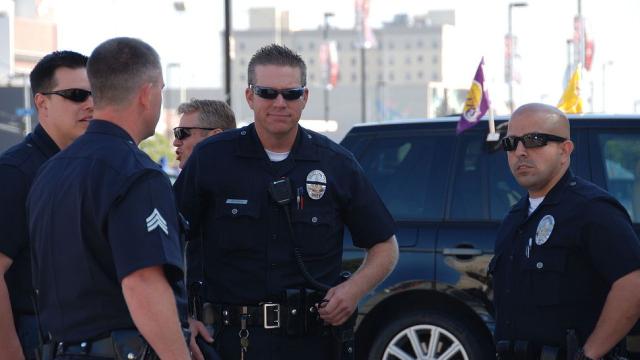A large-scale analysis of body-camera usage among police officers in the US and the UK has produced some rather unexpected and counter-intuitive results, showing that body-worn cameras have a tendency to increase assaults on police. At the same time, discretionary use of cameras increases an officer’s tendency to use force.
LAPD out on patrol. (Image: Chris Yarzab)
These surprising results, published today across two studies in the European Journal of Criminology and the Journal of Experimental Criminology, show that there’s still a lot to learn about body-worn cameras and how they should be used.
According to the new research, assault rates against officers jumps by 15 per cent when body-worn cameras are used. What’s more, and contrary to conventional belief, the rate of violence imposed by cops on citizens is not influenced by the presence of body-worn cameras. But — and this is a big but — if officers switched their cameras on and off during their shift (that is, discretionary use), the likelihood that they would use physical force increased. If they kept their cameras rolling, on the other hand, the rates of police violence decreased.
Body-worn cameras are increasingly being seen as a way to reduce police violence and assaults on officers. The general consensus out there — both among the public and police — is that body-worn surveillance technologies will make police more accountable, which should result in safer streets for everyone. The trouble is, there’s a surprising lack of data to support this claim. Investigations in Seattle and New Orleans have been mixed, but these devices have resulted in the indictment of killer cops. Moreover, these devices are often used to protect police officers, and in many cases, cops are blatantly refusing (either actively or passively) to use these devices, whether they be bodycams, dashcams or other cop-tracking technologies.
Prior to the two studies released today, the most-cited investigation on the matter was conducted in Rialto, California. This problematic pilot project, which pulled data under controlled conditions in an agonisingly small community of about 100,000 people and 30 cops, has been used to justify huge government investments in this policing technology. For a field of inquiry as important as this, precious little evidence actually exists.
In an effort to overcome this knowledge gap, criminologists from the University of Cambridge and RAND Europe worked with eight police forces across the US and the UK, including departments in the California cities of Ventura and Rialto, and departments in West Midlands, Cambridgeshire and Northern Ireland. In all, the researchers had 10 randomised-controlled trials to work with.
The researchers studied the shift patterns of 2122 participating officers who were randomly divided into two groups — one group with body cams and one without. In total, over two million policing hours were studied amid a total population of more than two million people.
Officers equipped with body cams were told to record all stages of police-public interactions and issue a verbal warning when filming was about to commence. Despite this protocol, however, many officers preferred to use their discretion, switching on their cameras depending on the situation. This would prove to be the difference that made the difference.
Averaged over the 10 trials, the body-worn cameras had no effect on police use of force. A lot of people won’t like that conclusion, but the devil lay in the details. When police officers adhered to the protocol, their use of force was reduced by 37 per cent compared to camera-free shifts. But when officers used their discretion as to when to film, police use-of-force increased 70 per cent compared to camera-free shifts.
That’s a huge discrepancy. This research importantly highlights the need for police to keep their cameras rolling at all times. And now that evidence exists showing that cameras actually increase risk of assaults against cops, “more attention should be paid to how these devices are implemented,” say the researchers.
The researchers also found that rates of assaults against officers equipped with cameras were, on average, 15 per cent higher compared to when they weren’t wearing the cameras. It’s possible that officers felt more confident about reporting assaults once an incident was recorded on camera, thus making them more inclined to report it. But camera footage may also be making officers less assertive and more vulnerable to assault. The answer isn’t immediately obvious.
“The combination of the camera plus the early warning creates awareness that the encounter is being filmed, modifying the behaviour of all involved,” noted principle investigator Barak Ariel in a University of Cambridge release. “If an officer decides to announce mid-interaction they are beginning to film, for example, that could provoke a reaction that results in use-of-force.” Ariel says his team’s data suggests this could be what is driving the results.
“It may be that in some places it’s a bad idea to use body-worn cameras, and the only way you can find that out is to keep doing these tests in different kinds of places,” said Ariel. “After all, what might work for a sheriff’s department in Iowa may not necessarily apply to the Tokyo PD.”
The researchers say these findings are both preliminary and unexpected, and agree that further scrutiny is most certainly required.
“At present, there is a worldwide uncontrolled social experiment taking place — underpinned by feverish public debate and billions of dollars of government expenditure,” write the researchers. “Robust evidence is only just keeping pace with the adoption of new technology.”
[European Journal of Criminology and Journal of Experimental Criminology]
